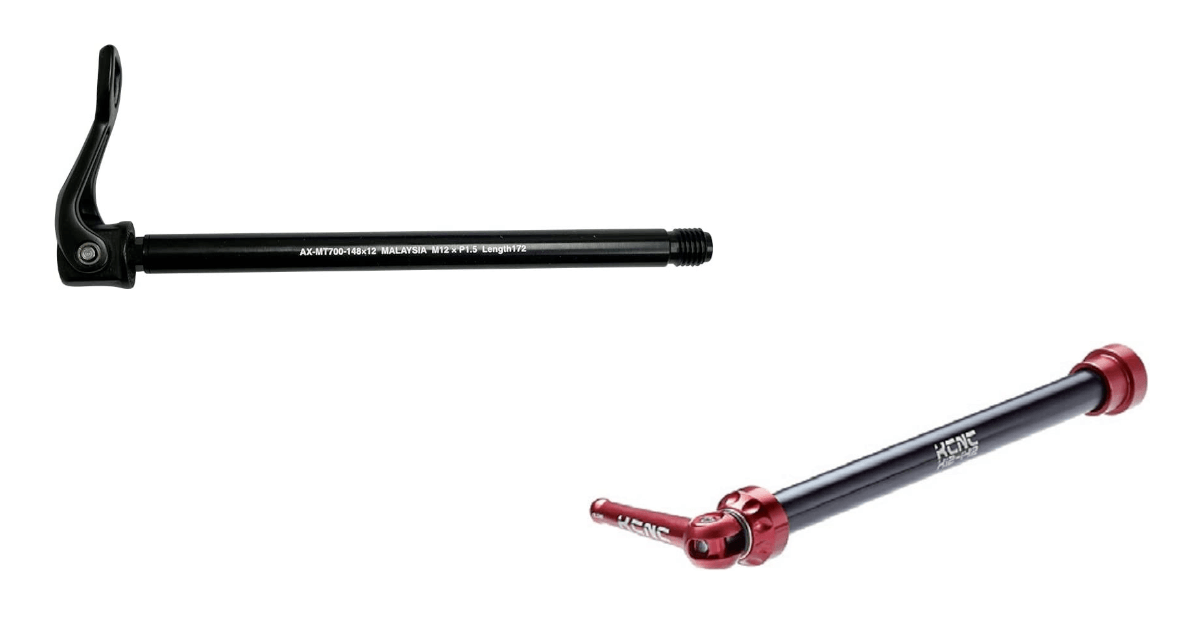What is a through-axle?
A through-axle is a type of shaft that passes through the wheel hub to secure the wheel to the frame/fork.
In the past few years, a quick-release type of shaft was used to secure the wheel, but with the spread of disc brakes in recent years, through-axles have been adopted for disc brake wheels because of their higher fixing force and rigidity.
Advantages of Through Axle
Through-axle is used in disc wheels for the following reasons.
- because it is fixed with screws, it is resistant to lateral forces
- the disc rotor position is the same every time
Quick release wheels are secured by “clamping” the wheel from both sides, but through-axle wheels are secured by threading and a special mechanism, which increases the securing force and resistance to lateral torsion.
Another important point is that the threading “keeps the disc rotor in the same position every time. Disc brakes are brakes that sandwich the rotor between the pads, and even a slight discrepancy of a few millimeters can lead to reduced braking effectiveness and abnormal noise.
Quick release brakes can be slightly misaligned depending on how they are tightened, but with through-axle brakes, the rotor is fixed in the same position every time, so misalignment of the rotor position is less likely to occur.
Can a click release be replaced with a through-axle?
Basically, it is not possible to convert a quick-release sportbike to a through-axle.
This is because of the following reasons
- frame/fork ends are not threaded
- the rear has different end widths
Through-axle cannot be fixed if the end of the frame/fork is not compatible with through-axle (e.g. threading). Quick release usually has a pawl system for the end and no threading.
Also, through-axles for road bikes are usually 100 mm at the front and 142 mm at the rear, while quick releases are usually 100 m at the front and 130 mm at the rear, so the widths will not match in the first place for the rear.
Through-axle type
Differences in axle thickness
Through-axles come in different thicknesses.
12mm is the most common for road bikes, and MTBs are also often 12mm, but some use 15mm thickness, and some bikes may use an even thicker 20mm shaft.
The shaft thickness should be selected according to the thickness of the threading on the frame/hawk side and the size of the shaft hole in the wheel hub.
Some wheels may accommodate through-axles of various thicknesses by engaging an adapter.
Differences in axle length
As explained earlier, the most common through-axle lengths for road use are 100mm front and 142mm rear. For MTB, 110mm front is the most common, and 142mm rear is the most common, but there are also 135mm end widths, which are common on older MTBs, and 142+, Specialized’s own standard, and There is also a 148mm width called the Boost standard.
Axle length varies depending on the character of the bike, but it also affects your choice of replacement parts in case of breakdown or customization, so check carefully when purchasing.
Differences in Fixing Methods
The main type of through-axle is the one in which the shaft is tightened into the threading of the frame/fork, but there is also a special fixing method called the “R.A.T system” developed by Focus and used on some Merida sport bikes and others.
Naturally, special fastening methods require special forks, frames, and axles themselves.
Difference in Threading Pitch
The same threaded through-axle cannot be used if the thread pitch (the length of the distance between the valleys and peaks of the bolt threads) is different. On some bikes, the thread pitch of the axle may be different on the front and rear.
The pitch of through axles can be 1mm, 1.5mm, 1.75mm, 2mm, etc.
When replacing the axle itself, the basic rule is to match the standard currently used. However, if the receiving bracket is threaded and fixed to the frame, it may be possible to use a through-axle shaft of a different standard by replacing the receiving bracket.
How to Choose a Through-Axle
As we have seen, when choosing a through-axle, the following four points must fit your bike.
- shaft length
- shaft thickness
- fixing method (threading, special method, etc.)
- thread pitch
Although third-party adapters to replace threading of different thickness and pitch are available through mail-order or other means, it is best to use the manufacturer’s genuine product for fixing strength and stability.
